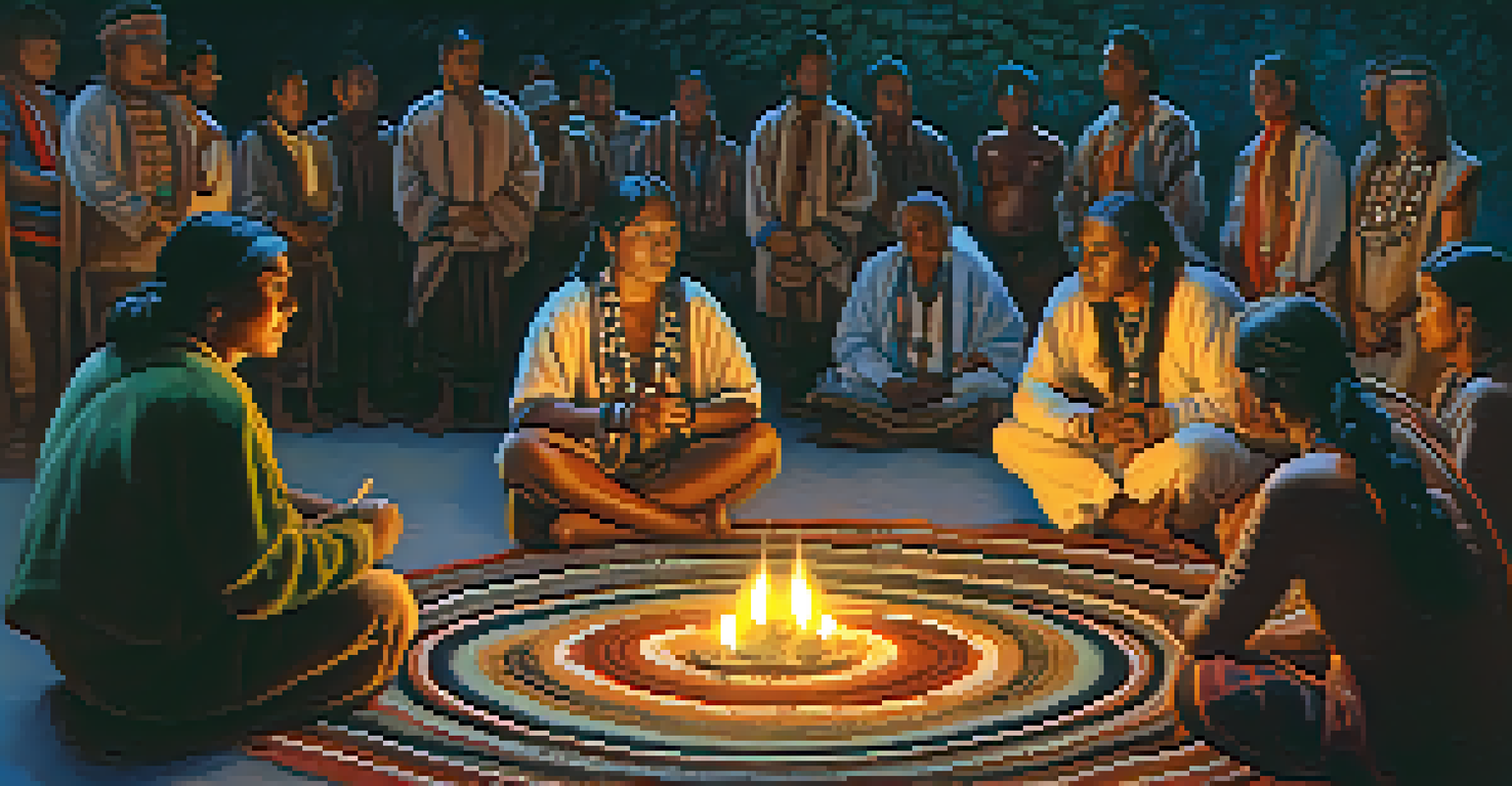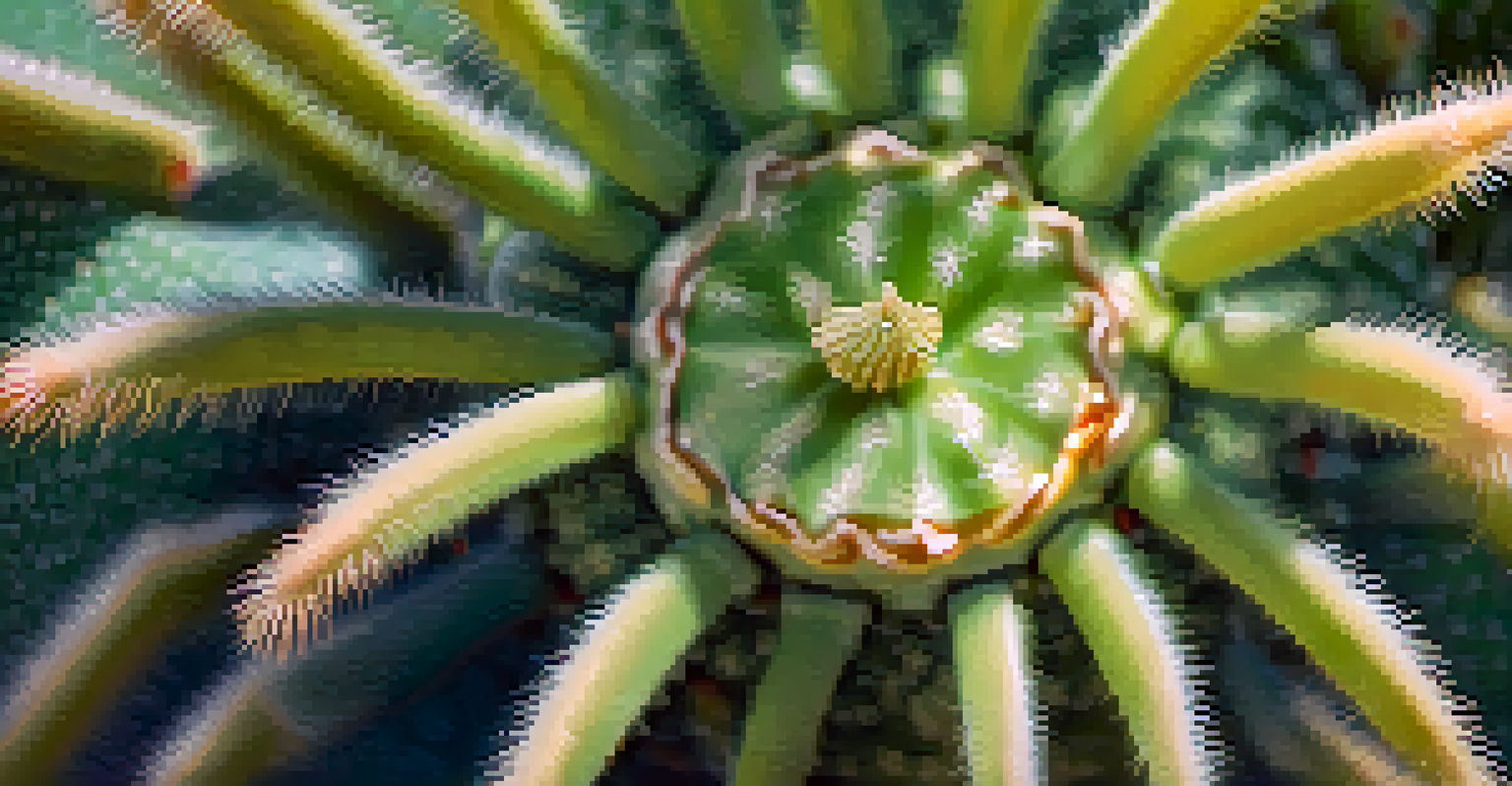The Role of Peyote in Strengthening Cultural Identity Today

Understanding Peyote: More Than Just a Plant
Peyote, a small cactus native to Mexico and the southwestern United States, is known for its psychoactive properties, primarily due to the compound mescaline. However, its significance extends far beyond its hallucinogenic effects; it serves as a powerful symbol of identity for many Indigenous communities. In these cultures, Peyote is not merely a plant but a spiritual ally that fosters deep connections to ancestral traditions and beliefs.
Peyote is more than just a plant; it is a symbol of identity and a tool for spiritual connection.
For many Indigenous peoples, Peyote has been used for centuries in religious ceremonies, serving as a conduit for spiritual experiences. These rituals often emphasize healing, introspection, and community bonding, illustrating how Peyote is interwoven with cultural practices. The act of consuming Peyote in a ceremonial context is a profound expression of faith and identity, reinforcing the values and stories that define these communities.
In recent years, as Indigenous rights and cultural preservation movements gain momentum, the importance of Peyote has been highlighted even further. It stands as a testament to resilience, inviting younger generations to engage with their heritage. This revival of interest in Peyote reflects a broader trend of reclaiming cultural practices that have been marginalized or suppressed.
The Spiritual Significance of Peyote in Ceremonies
Peyote plays a central role in many Native American Church ceremonies, where it is consumed to facilitate spiritual journeys and communal healing. These ceremonies often bring together individuals from various tribes, fostering a sense of unity and shared purpose. Through the collective experience of Peyote, participants can explore their spirituality while reinforcing their cultural identities.

The rituals surrounding Peyote consumption are rich with symbolism and meaning. Participants often sing songs, engage in prayer, and share stories that connect them to their ancestors and the natural world. This spiritual framework allows individuals to articulate their identities in a safe and supportive environment, emphasizing the importance of community in the process of cultural affirmation.
Peyote's Cultural Significance
Peyote serves as a spiritual ally for many Indigenous communities, symbolizing identity and connection to ancestral traditions.
Moreover, the use of Peyote in these ceremonies often serves as a form of resistance against cultural erasure. By engaging in traditional practices, Indigenous peoples affirm their existence and resilience in a world that has often sought to diminish their voices. As such, Peyote becomes a symbol of both spiritual strength and cultural survival.
Peyote as a Symbol of Resistance and Resilience
The history of Peyote use among Indigenous peoples is fraught with challenges, including legal battles and cultural misunderstandings. Despite these obstacles, Peyote remains a powerful symbol of resistance against colonization and cultural oppression. Its continued use in spiritual practices is a statement that these communities will not be erased or forgotten.
In the struggle for cultural survival, Peyote stands as a testament to resilience and a commitment to heritage.
In many ways, the fight to protect the rights to use Peyote mirrors broader struggles for Indigenous sovereignty and self-determination. Activists and leaders advocate for the recognition of Peyote as a sacred plant, pushing back against stigmas and misconceptions. This advocacy highlights the importance of respecting Indigenous spiritual practices and acknowledging their significance in contemporary society.
Through this lens, Peyote serves as a reminder of the resilience inherent in Indigenous cultures. It provides a connection to the past while also empowering future generations to embrace their identities. By reclaiming Peyote, these communities assert their right to exist and flourish, both spiritually and culturally.
Modern Context: Peyote and Cultural Revitalization
In today's world, many Indigenous communities are experiencing a cultural revitalization that includes the resurgence of Peyote ceremonies. This revival is not merely about spiritual practices; it represents a broader movement to reclaim and celebrate Indigenous identities. As younger generations reconnect with their heritage, Peyote plays a critical role in this journey of discovery and affirmation.
Social media and digital platforms have also facilitated this cultural renaissance, allowing for the sharing of stories, experiences, and teachings related to Peyote. Online communities provide spaces for dialogue and education, empowering individuals to explore their identities and the significance of Peyote in their lives. This digital engagement fosters a sense of belonging and connection among Indigenous peoples across vast distances.
Resistance Through Peyote Practices
The use of Peyote in ceremonies embodies resistance against cultural erasure and affirms Indigenous resilience and sovereignty.
Moreover, the revitalization of Peyote practices often intersects with other cultural expressions, such as art, music, and storytelling. These forms of expression allow individuals to articulate their experiences and identities in diverse ways, enriching the cultural tapestry of Indigenous communities. In this context, Peyote becomes a unifying force that strengthens cultural pride and collective identity.
The Role of Education in Peyote Awareness
Education plays a crucial role in fostering understanding and respect for Peyote among non-Indigenous populations. By sharing the cultural and spiritual significance of Peyote, educational initiatives can help dismantle stereotypes and promote a more nuanced appreciation of Indigenous traditions. This awareness is vital in creating a more inclusive society that honors diverse perspectives.
Incorporating Indigenous knowledge and practices into curricula can also empower Indigenous students to take pride in their heritage. Understanding the role of Peyote in their cultural identity can enhance their sense of belonging and strengthen their connection to their communities. This educational approach affirms the value of Indigenous wisdom and encourages respect for traditional practices.
Furthermore, collaborations between Indigenous and non-Indigenous educators can pave the way for meaningful dialogue about Peyote and its significance. By creating platforms for discussion, both groups can learn from each other and foster mutual respect. These educational efforts can ultimately contribute to a more informed and empathetic society.
Challenges Facing Peyote and Indigenous Communities
Despite its cultural significance, Peyote faces numerous challenges today, including habitat loss and overharvesting. As demand for Peyote increases, particularly among non-Indigenous users, the sustainability of this sacred plant is at risk. This situation highlights the need for responsible stewardship and conservation efforts to protect Peyote and its cultural heritage.
Additionally, the legal status of Peyote remains a complex issue. While some Indigenous groups have protections under the American Indian Religious Freedom Act, these rights are often contested. The ongoing legal battles surrounding Peyote use underscore the broader struggles for Indigenous rights and the recognition of their cultural practices.
Revitalization of Indigenous Identities
Modern movements to reclaim Peyote practices highlight a broader cultural revitalization and the importance of educating about its significance.
These challenges can create a sense of urgency among Indigenous communities to advocate for the preservation of Peyote and their cultural practices. By raising awareness about these issues, they can garner support from allies and educate the public on the importance of protecting both the plant and the traditions associated with it. This collective effort is crucial in ensuring that Peyote continues to be a vital part of their cultural identity.
Looking Ahead: The Future of Peyote in Cultural Identity
As we look to the future, the role of Peyote in strengthening cultural identity remains pivotal for many Indigenous communities. The ongoing efforts to revitalize and protect these practices reflect a deep commitment to cultural survival and resilience. By embracing their heritage, Indigenous peoples can shape a future where Peyote continues to be a source of spiritual strength and identity.
Engaging younger generations in Peyote ceremonies and teachings is essential for passing down traditions and ensuring their continuity. As these young people learn about the significance of Peyote, they become both custodians of their culture and advocates for its preservation. This intergenerational transmission of knowledge is vital for maintaining the cultural fabric of Indigenous communities.

Ultimately, the future of Peyote in cultural identity will depend on a collective commitment to respect, understanding, and collaboration. By fostering a greater appreciation for the significance of Peyote, both Indigenous and non-Indigenous communities can work together to ensure that this sacred plant remains a vibrant part of cultural identity for generations to come.